Martina Richter reviewed three pilots’ watches, each with one conspicuous feature in common: an extremely large case, like those of the earliest watches for aviators. Scroll down to read the results, along with original photos by Zuckerfabrik Fotodesign.
IWC’s Big Pilot’s Watch Top Gun Miramar and Zenith’s Pilot Montre d’Aéronef Type 20 GMT have 48-mm-diameter cases. The case of the Bell & Ross BR 03-51 GMT, a square, is 42 mm across. Both the Bell & Ross and the Zenith have a GMT function, which means the time in a second time zone is shown on the dial independently from the main time display. The watches from IWC and Zenith share two common traits: each has an in-house movement and both are associated with important chapters in pilots’-watch history. We collaborated with helicopter pilot Mirza Kaufmann, who flies a rescue chopper for Germany’s ADAC automobile club, the equivalent of our AAA, for our review.

While Bell & Ross began in Paris in 1992 and is much younger than IWC or Zenith, the company has been making watches for use aboard aircraft from its earliest days. Its goal has been to create watches that meet Swiss watchmaking standards and can withstand extreme stress. Its watches are worn by professional divers, astronauts, mining personnel and other specialists as well as by pilots. The company’s Aviation line of watches, which includes the model we reviewed, recalls the look of vintage cockpit instruments.

Schaffhausen-based IWC has been making pilots’ watches since 1936, when the company introduced a special watch for aviators. It had a black dial and large, bold, luminous numerals and hands. The company followed this in 1940 with the Big Pilot’s Watch 52 T. S. C. It had a 55-mm-diameter case and a weight of 183 grams and remains the largest wristwatch ever made by IWC. A so-called “observation” watch, it had a central sweep-seconds hand, which could be stopped for to-the-second time setting and for synchronizing with other pilots’ watches.
IWC’s new Big Pilot’s Watch, introduced in 2002, was inspired by its historical predecessor, but rather than housing a pocketwatch movement like its forebear, the new model was equipped with modern manufacture Caliber 5000, which has automatic winding and a seven-day power reserve. The Top Gun edition, which has been part of IWC’s family of pilots’ watches since 2007, combines a 1940s’ instrument-style look with modern technology and contemporary materials. Five new Top Gun models were introduced in 2012; the Miramar in our review is part of this group. It pays homage to the California city that was home to the first U.S. Navy Fighter Weapons School, from 1969 to 1996, known as the “Top Gun” flight-training program.

center of the dial, apart from the minutes and seconds.
Zenith was one of the first watch brands to build observation watches and cockpit instruments for pilots. The original Zenith Type 20 “onboard watch” (montre d’aéronef in French) appeared on the instrument panels of many planes starting in 1938, including the Caudron Simoun C.635, which the French Air Force used for surveillance. “Type 20” was used to summarize the specific requirements of watches worn by professional pilots. Among other specs, these watches had to be able to withstand sudden temperature fluctuations, strong magnetic fields, atmospheric disturbances and the bone-jarring vibrations of airplane engines. Legibility requirements were met with large black dials, oversized Arabic numerals, and hands coated with plenty of white luminous material. Type 20 watches were also equipped with special, easy-to-grasp crowns that pilots could pull out and turn without having to remove their gloves.
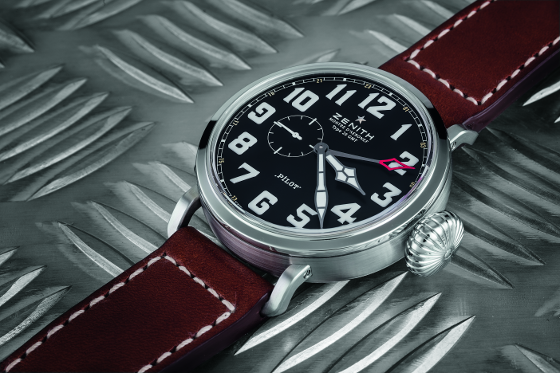
The new Pilot Montre d’Aéronef Type 20 in our review is the successor to Zenith’s first pilots’ watch. It is equipped with a GMT function (GMT, for Greenwich Mean Time, is now known as Coordinated Universal Time and remains the standard time system used by pilots). The GMT function of yesteryear, which displayed Greenwich Mean Time alongside the primary time, has evolved into a variable indicator for whichever second time zone the user requires. Helicopter pilot Kaufmann confirmed that pilots appreciate the functionality of a second-time-zone display. On the Zenith watch’s dial, a long central hand with a large red arrowhead at its end shows the hour in a second time zone. This hand can be easily repositioned by means of an elongated push-piece at 10 o’clock. It advances in one-hour increments each time the push-piece is pressed. The hand completes one circuit of the dial every 24 hours.
If you aren’t using the Zenith’s GMT hand to show the time in a second zone, you can simply let it serve as a 24-hour hand. The 24 hours are shown on a finely calibrated railroad-style scale along the dial’s edge, but this scale is marked so lightly that it’s hard to read with the naked eye. But Zenith’s indicator is clearer than the GMT function on Bell & Ross’s watch, which only has a 12-hour cycle. This is a drawback because a second time zone really only makes sense if it’s calibrated for 24 hours. When it isn’t, it’s hard to tell whether a given hour in the second time zone is a.m. or p.m.
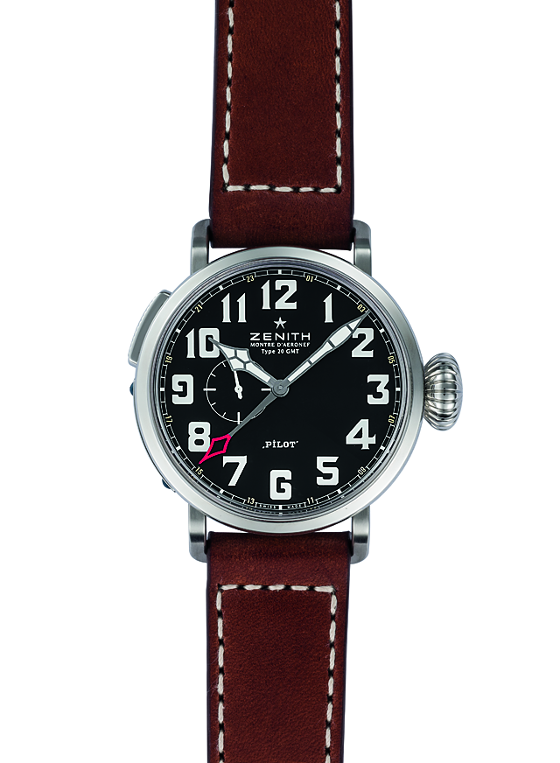
Furthermore, the indicator for the second zone on the Bell & Ross isn’t as easy to bring into position as it is on the Zenith, so if you choose the Bell & Ross, you’ll want to follow these instructions carefully. Pull out the crown to its third position (the hand-setting position) and turn the crown counterclockwise. This will cause the hands for the primary time to move clockwise along with the hands for the second zone’s time, which turn on the subdial at 6 o’clock. Now that you’ve correctly set the hands for the second zone’s time, turn the crown clockwise to set the hands for the primary time. The hour hand for the second zone will remain motionless while the minutes hand for this zone moves backwards in synchrony with the hands for the primary time.
This procedure may take a bit of getting used to, especially since when you set the hands for the second time zone you must also pay attention to the big date display: this indicator automatically advances when the primary time zone’s hour hand passes midnight and won’t turn the other way. Fortunately, if you inadvertently move the date forward while setting the hands for the primary zone and the second zone, you can quickly correct your mistake using the rapid-reset function for the date display, which is activated when the crown is in its middle position.
Bell & Ross’s movement is based on Soprod’s relatively new Caliber A10 and enhanced with the TT651.24H module from Technotime. Caliber A10 has been on the market since 2010 and is regarded as an alternative to the ETA 2892-A2, for which Technotime originally built the module. The TT651.24H can be used to power either a second time zone or, as its name suggests, a 24-hour disk with a day-night indicator. The module includes a double-disk big date display. If the watch is running, the date display advances almost exactly at midnight, although it’s hard to see this change because the wide hands for the primary time zone hide almost the entire window of the big date display. Bell & Ross’s watch is the only one in our comparative test that doesn’t have a manufacture caliber, but its rate results were good. Measured on our electronic timing machine, the BR 03-51 GMT gained an average of 5.9 seconds per day when fully wound and an average of 1.8 seconds per day after running for 24 hours. On the wrist, this watch showed a respectable average gain of 2.25 seconds per day.

The Zenith watch contains an enhanced version of the brand’s in-house Elite caliber, introduced in 1994. In its modified version, with a second time zone, it has since 2012 been designated as number 693. It provides nearly all of the features of the basic caliber: a bidirectionally winding and ball-borne rotor, a 50-hour power reserve, a subdial for the running seconds, and a stop-seconds function for to-the-second time setting. The family of Elite calibers isn’t as diverse as that of the El Primero, Zenith’s famous automatic chronograph movement, but it nonetheless includes earlier versions with a second time zone (numbers 672 and 682). The difference in version 693 is the absence of a date display, which we think was left out as an historical allusion to the Pilot Montre d’Aéronef Type 20, but which some contemporary pilots might regard as a deficiency.
This caliber’s small diameter (25.6 mm) requires inserting a wide retaining ring between it and the rim of the case. Circular graining embellishes this ring, but only partially conceals the 22.4-mm difference between the diameters of the Elite caliber and the steel case. However, the movement and the retaining ring are hidden behind the opaque caseback, so their mismatched sizes are seldom seen. Eight screws secure the solid-steel caseback, which is decorated with Zenith’s shield-shaped emblem and an engraving of the airplane flown by Louis Blériot, the pioneering French aviator who, in July 1909, became the first person to fly across the English Channel. (He himself built the aircraft that he flew on the crossing.) The phrases “Zenith Flying Instruments” and “Montre d’Aéronef Type 20” arc around the embellished central disk. The Elite caliber ran with good and only slightly divergent rate results: it gained 4.1 seconds during the first day after it had been fully wound and its daily loss was 0.8 seconds after running for 24 hours. The timekeeping was excellent on the wrist, where it scarcely deviated from perfect results during a two-week test.
IWC’s manufacture Caliber 51111 is a member of its caliber family 5000, which debuted in 2000. This is one of the largest automatic movements made by IWC and was designed especially for the Big Pilot’s Watch. With a stately diameter of 37.8 mm, it does not need a broad retaining ring and can be screwed directly into the large case of the Top Gun Miramar. Caliber 5000 has undergone several changes during the past 14 years. Its frequency was increased from 18,000 to 21,600 vph, which necessitated a complete reworking of the gear train. The revisions began with the barrel, to preserve the full 168 hours, or seven days, of its power reserve. This movement could run even longer, but it’s stopped after seven days so it doesn’t suffer the effects of reduced power as the mainspring unwinds completely.

IWC’s Caliber 51111 delivered very well-balanced performance: it gained 2.5 seconds during the first day after it had been fully wound and 2.1 seconds on the second day. The watch performed excellently during our two-week-long wearing test: its deviation from perfect timekeeping never exceeded 1 full second per day. This movement’s patented self-winding ratchet system recently underwent improvement. To reduce wear, the new system uses ceramic ratchets to pull a specially hardened stainless-steel wheel. All IWC automatic winding systems will gradually be brought up to this technical standard. The interesting architecture of Caliber 51111 is hidden behind an opaque, fully threaded, screw-in back. A Top Gun plaque in the middle of the caseback failed to survive the aerobatic maneuvers of our ADAC test pilot. When the stunts were done, the plaque had separated from the caseback and the chopper’s captain held the loose component in his hand. Despite the mishap, he liked this pilots’ watch.
IWC’s Top Gun Miramar blends new features with the company’s pilots’-watch heritage: modern materials and the observation-watch styling of the 1940s, camouflage colors and high standards of legibility, and a roughhewn appearance with the price tag of a luxury watch. The glossy gray zirconium oxide case looks luxurious. Its ceramic material is “baked” at 2,000 degrees Cº and then processed with diamond-tipped tools. This material is antimagnetic, acid-resistant, lightweight and kind to the skin. The matte gray titanium used for the back and for the distinctively large crown has the same properties. (IWC and Porsche Design pioneered the use of titanium in watch construction in the 1970s.) The crown’s conical shape and deep ridges contribute to the Top Gun Miramar’s ease of operation. The crown can be screwed down or pulled out easily for rapid resetting of the date display and for setting the hands. The gray of the dial matches the crown. The numerals, indexes and hands are beige. This is an unconventional color combination, but it works well and complements the sturdy green fabric strap, which is secured by a pronged buckle.
Observation-watch styling inspired the IWC’s dial, which has an outer wreath of strokes for the minutes and seconds and a red inner circle with red Arabic numerals for the hours. Aviators in the 1930s and ’40s had to be able to read the minutes and seconds with great accuracy for navigational purposes, so many pilots’ watches showed them on a separate ring so they would be easier to see. The dial has a power-reserve display at 3 o’clock and a relatively large date indicator at 6. This date display is the only element that departs from the militarily inspired camouflage look: it has a white-on-black color scheme and is highly legible. This watch remains easy to read in the dark. Luminous material glows on all the hands except the seconds hand; it also coats the indexes at 3, 6 and 9, as well as the orientation triangle above the 12.

By comparison, the dial of the Zenith Pilot Montre d’Aéronef Type 20 looks like a fireworks display of luminous numerals and hands. Twelve vintage-style Arabic numerals are made entirely from white Super-LumiNova, contrasting sharply with the matte black dial and rising above it. They and the ruthenium hands for the hours and minutes all glow bright green in the dark. The little white seconds hand above its subdial at 9 o’clock and the steel hand with a red tip for the second time zone are readily visible by day, but cannot be seen at night. The Pilot Montre d’Aéronef Type 20 inherited its dial design from Zenith’s first pilots’ watch. It also shares that watch’s 48-mm-diameter case and its large, fluted, onion-shaped crown, which can be easily screwed shut or pulled out and turned to wind the mainspring or set the hands. A plaque below the time-zone button on the left side of the case bears the letters “HB,” the country code for Swiss airline registration. The letters are followed by a numeral specifying each watch’s serial number. Two angular and relatively narrow but well-made stirrups are screwed to the satin-finished middle piece of the case. These hold the sturdy-looking brown calfskin strap, which has contrasting stitching that gives it a high-quality and authentic look. A robust pronged buckle bearing Zenith’s star emblem secures the strap. The case of the Bell & Ross watch is PVD-coated stainless steel. The movement is inserted into the case from above and the caliber is screwed to the back. The bezel assembly is fastened to the case by four screws, one at each corner of the square. The slits in the heads of these screws are not positioned uniformly, a detail that might annoy some connoisseurs.

The crown is comparatively small but its large knurls make it easy to operate. It cannot be screwed shut. The dial is tidy and easy to read with just enough stylistic pep to keep things interesting. The primary hour hand is outlined in orange, the same color as the hour hand for the second time zone. The two windows of the big date display are positioned under the 12. Only the date’s digits, the 9 and the 12 are shown as large Arabic numerals on the matte black dial. The remaining hours are marked by index strokes. When the lights go out, the 9, the 12, the hour hand, the minutes hand and the indexes all glow in a handsome sky-blue color (a hue that could be an allusion to the fact that this watch is destined to take off into the wild blue yonder).
We admit that these three watches cannot be compared directly because their features and prices differ. Despite its manufacture movement, its well-balanced rate results and its high-tech material, IWC’s watch seems overpriced. Zenith’s model offers an appealing combination of functionality, simple operation, a manufacture movement, stable rate results and an acceptable price. Bell & Ross’s watch has an unbeatable price, but it doesn’t have a manufacture movement and its second-time-zone indicator shows 12, not 24, hours and is difficult to set.
SPECS:
Bell & Ross BR 03-51 GMT
Manufacturer: Bell & Ross, 8 rue Copernic, 75116, Paris, France
Reference number: BR03-51-S-88888
Functions: Hours, minutes, central seconds, big date, second time zone
Movement: Soprod TT651, based on Soprod A10, automatic, 28,800 vph, gold-plated brass balance, Incabloc shock absorption, 25 jewels, diameter = 25.6 mm, height = 5.1 mm, 40-hour power reserve
Case: PVD-coated stainless steel, sapphire crystal with non-reflective coating, water resistant to 100 m
Strap and clasp: Rubber strap with PVD-coated stainless-steel pronged buckle
Rate results – Deviations in seconds per 24 hours (Fully wound/after 24 hours)
Dial up +4.9 / +3.9
Dial down +4.1 / +1.2
Crown up +6.7 / -0.9
Crown down +5.3 / +3.0
Crown left +8.7 / +1.6
Greatest deviation of rate 4.6 / 4.8
Average deviation +5.9 / +1.8
Average amplitude:
Flat positions 273° / 248°
Hanging positions 240° / 211°
Dimensions: Diameter = 42 mm, height = 11.6 mm, weight = 158 grams
Variations: Titanium case with carbon fiber dial, synthetic strap with folding clasp ($5,500)
Price: $4,900
SPECS:
IWC Big Pilot’s Watch Top Gun Miramar
Manufacturer: IWC Schaffhausen, Baumgartenstrasse 15, CH-8201 Schaffhausen, Switzerland
Reference number: IW501902
Functions: Hours, minutes, central seconds, date, power-reserve display
Movement: IWC 51111, based on IWC 5000, automatic, 21,600 vph, Glucydur balance, Incabloc shock absorption, 42 jewels, diameter = 37.8 mm, height = 7.5 mm, 168-hour (7 days) power reserve
Case: Ceramic, titanium back, curved sapphire crystal with nonreflective coating on both sides, water resistant to 60 m
Strap and clasp: Textile strap with pronged buckle
Rate results – Deviations in seconds per 24 hours (Fully wound/after 24 hours)
Dial up +7.9 / +7.1
Dial down -0.1 / +5.8
Crown up +0.5 / -3.9
Crown down +0.6 / +5.1
Crown left +3.5 / -3.6
Greatest deviation of rate 8.0 / 11.0
Average deviation +2.5 / +2.1
Average amplitude:
Flat positions 338° / 280°
Hanging positions 287° / 249°
Dimensions: Diameter = 48.2 mm, height = 15 mm, weight = 124 g
Variations: Titanium case with black dial, strap with folding clasp
Price: $18,200
SPECS:
Zenith Pilot Montre d’Aéronef Type 20 GMT
Manufacturer: Zenith International SA, Rue des Billodes 34-36, CH-2400, Le Locle, Switzerland
Reference number: 03.2430.693/21.C723
Functions: Hours, minutes, small seconds, second time zone
Movement: Elite 693, automatic, 28,800 vph, Glucydur balance, Kif shock absorption, 26 jewels, diameter = 25.6 mm, height = 3.9 mm, 50-hour power reserve
Case: Stainless steel, curved sapphire crystal with nonreflective coating on both sides, water resistant to 100 m
Strap and clasp: Calfskin strap with pronged buckle
Rate results – Deviations in seconds per 24 hours (Fully wound/after 24 hours)
Dial up +9.3 / +4.5
Dial down +5.2 / +2.5
Crown up +1.6 / -9.3
Crown down +1.0 / +3.9
Crown left +3.4 / -5.7
Greatest deviation of rate 8.3 / 13.8
Average deviation +4.1 / -0.8
Average amplitude:
Flat positions 324° / 270°
Hanging positions 285° / 238°
Dimensions: Diameter = 48 mm, height = 15.1 mm, weight = 158 grams
Variations: Red Baron edition with DLC-coated titanium case, limited to 500 pieces ($8,600)
Price: $7,900
This article first appeared in WatchTime Magazine and has since been updated.




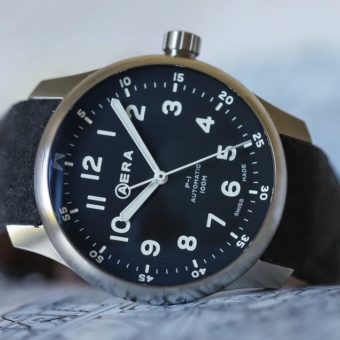
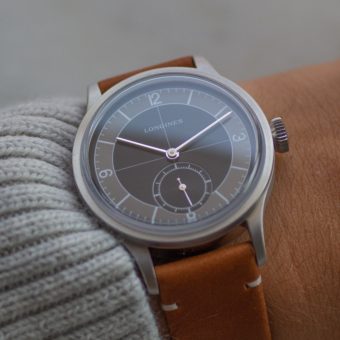
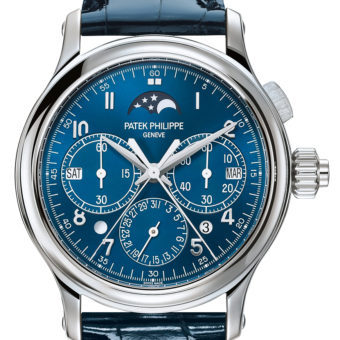
Most pilot watches I have found to be far too expensive, and contain useless or redundant features. Most pilot watches are really ego-prop-styling to let people know you’re a pilot (most people who wear “pilot watches” are not even pilots) . I’m not here to bag on the beautiful timepieces in this blog, but I am a pilot, and most watches don’t offer the right size, functions or readability( remember, flying is a multi-tasking, turbulent chore often done by aging pilots who can’t see small details up close anymore). With all the digital cokpits, synthetic vision, and smart apps like foreflight, what do pilots really need on their wrists? It might be different for everyone, but what I want is a big display so I can view it easily and at-a-glance, great back lighting for night flying and 3 basic things: 1) local time 2) Zulu (UTC) time and 3) a countdown timer that has a vibrating alarm. The last one is critical as cockpits are loud (along with noise cancelling headphones) the demure chimes from most watches would not be heard. I want to be able set my timer for recurring 20min intervals to track fuel consumption an other engine gauges… My exhaustive searching finally found this for @ $90 : The Casio G-Shock GD350-1B… Yes, It is not cool or sexy, but it’s tough, accurate, functional and purposeful. I love the irony that real pilots who actually fly would wear a $90 casio while their fancy passengers are wearing $6000 Breitlings.